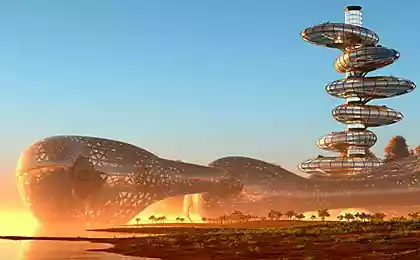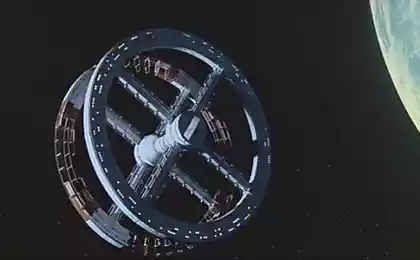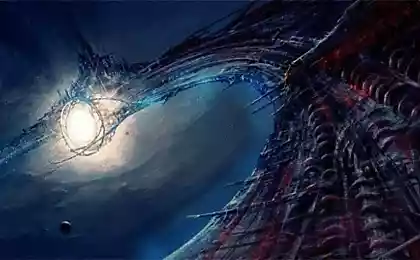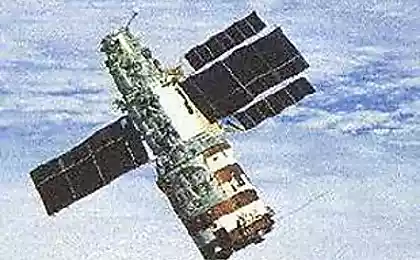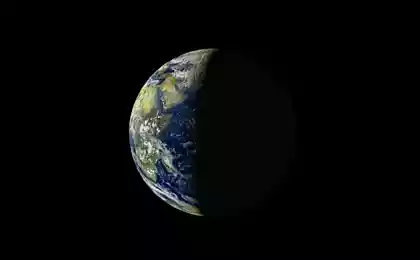762
Theoretically possible space megastructure

Probably the bulk of the science fiction of all time of its existence - since "Flight to the moon right way for 97 hours and 20 minutes" by Jules Verne - anyway operates with grand food science and engineering. With the development of progress and expanded the boundaries of imagination of scientists and writers, even today in popular science and science fiction have already been described engineering structures that are in scope and daring design worthy of the term "megastructure". We decided to collect a kind of rating agencies. With some of them you already know, and some will be new.
Space Elevator

(C)
The idea was first formulated more lift Konstantin Tsiolkovsky in 1895. Today this technology is seen as a future way of cheap and sustainable access to low-Earth orbit. Cable, stretching into the sky on the tens of thousands of kilometers of the geostationary orbit, in which the moving lift, carrying cargo into space and astronauts. One end of the rope is fastened to the surface of the planet, and the second with a counterweight attached will be located above the geostationary orbit. In the role of counterweight can be a suitable asteroid.

Ideally, the space elevator has to be a step towards the creation of space shipyard. According to some studies, the elevator could be built after the invention of extremely durable materials. For example, as a promising material treated carbon nanotubes. While some scientists are skeptical that even the strength of the material would be enough to not break the cable.
Stanford Torus

This is the first and smallest of the inhabited ring structures in our list. The name Stanford Torus was due to a 10-week program for the development of engineering systems, held in 1975 among students at Stanford University. In that year, a group of students proposed to create a manned station, a colony of 10 000 inhabitants in the form of a toroidal structure with a diameter 1, 8 km. More precisely, she would like a wheel: in the center of the station were asked to place a "hub", consisting of a system of mirrors that reflect the light on the inside of the torus.


The hub must be connected to the rim by means of radial transport corridors, it also must be placed mooring gateways. To provide an artificial gravity at 1 g, the station revolves around an axis extending perpendicularly to the plane of the torus, a speed of 1 rpm. Torus itself can be closed - that is, be a looped tube and open in a looped chute. In the second case, the atmosphere is kept inside the station due to the centrifugal force.
I must say that the idea of creating a toroidal rotating station-settlement belongs is not stenfordtsam students. The concept is mentioned in the book of Herman Potocnik (1928), in one of the works of Werner von Braun (1952), as well as in the Soviet popular science film "The Way to the Stars" 1957 year.
The idea of building a space station in the form of a torus is very popular in science fiction, video games and cinema. One of the most famous versions depicted in the cult movie "Space Odyssey 2001".

A much larger version of the Stanford torus (with some reservations) is shown in the film Elysium (2013), there is a 40-kilometer ring - open-ended - is home to 10 million inhabitants
.

Bernal Sphere

(C)
In 1929, John Bernal put forward the idea of a space settlement in the form of a hollow rotating sphere filled with an atmosphere suitable for the person. With a diameter of 16 km of this sphere can become a home for 20 000-30 000 people. However, quite a comfortable level of gravity is provided only in the equatorial belt.
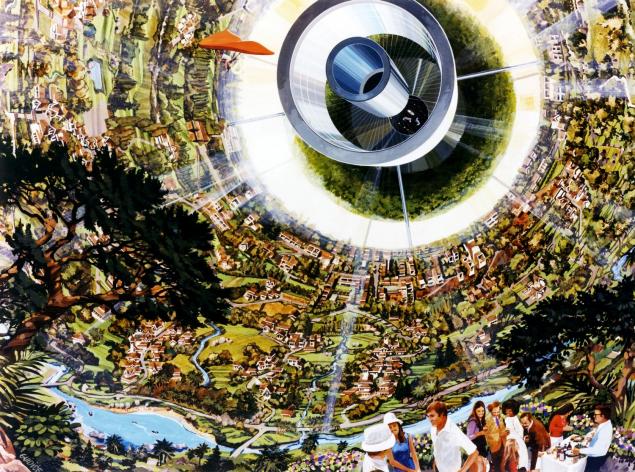
The stations, built in the form of spheres Bernal, found in various works of fiction and games. For example, in the game "Mass Effect" (station "Gagarin"), or in the novel "2312" Kim Stanley Robinson, where the role of the spheres Bernal performed inside a hollowed-out asteroids.
O'Neill Cylinder

In 1974, Gerard O'Neill in his article "Colonization of Space" for Physics Today magazine described the idea of a gigantic cylindrical station. Cylinder length of 32 km and a diameter of 8 km consists of six alternating longitudinal sections: three transparent and three inhabited. Outside the cylinder, opposite the "window" located giant mirrors to direct sunlight inside the cylinder. Gravity is provided due to the centrifugal force. Each of the three inhabited segment represents a "country." There are also separate external ring of larger diameter for agriculture, as well as external industrial section located on the outside of the cylinder axis of rotation.
Each country can accommodate up to one million inhabitants and with an increase in diameter and / or length of the cylinder - and even more. According to O'Neill, cylinders can reach a diameter of 24 km and 120 km long. The area inside the residence giants would amount to about 18 000 square kilometers.
Despite the fact that the cylindrical station received the name of O'Neill, a similar idea has been described in the novel by Arthur C. Clarke "Rendezvous with Rama", released in 1973. So it is possible that the idea was picked up by O'Neill and students exposed to detailed design.

Fresh examples of O'Neill cylinder can cause the film Interstellar (Station "Cooper»).
Star
death

(C)
most famous mega structure in science fiction. According to the literature, the universe of "Star Wars," such space stations was built a few pieces, and they were meant to keep in check the subjects of the Empire - what could be more terrible than the destruction of an entire planet?
In different parts of the space epic indicate different diameters Stars Death: from 120 to 900 km in diameter. By the way, the smallest station in diameter close to Epimetheus, Saturn, and Paku, satellite of Uranus. The crew of the Death Star is about 8 million people.
Globe Cassus

The draft proposed megastructure Swiss architect and artist Christian Valdfogelem in 2004. It is flattened at the poles "geodesic icosahedron" with two giant transparent sections for lighting. Gravity provides traditionally - with the help of the rotation. The diameter of the structure - 85 000 km (from Earth - about 12 600 km). For the habitat available to the scope of two segments located opposite each other in the equatorial zone, with the highest level of gravity. The higher "tropical" areas can be located agricultural areas and the polar regions, with their microgravity, can be used as a sort of warehouse and industrial sites.
In fact, according to the plan Valdfogelya, within the sphere should be placed ... all contents of the Earth. That is, the planet will have to, as it were turned inside out and create an artificial atmosphere, oceans and continents. Quite a bold plan. However, the author does not say where and how you need to wait to mankind at the time of transportation of the contents of the planet.
World-ring

(C)
In 1970, his novel "World-Ring" by Larry Niven. This is not a miserable torus in Earth orbit - is inhabited a closed ring around the star. Radius - 1 astronomical unit, ring width - 1, 6 million square kilometers, the length - 940 million km. Simply unimaginable amount of space for the development of an advanced civilization. And this civilization must be very highly, to be able to build a ring world. You'll laugh, but not without rotation to create gravity and keep the atmosphere. Because in this world there is no natural cycle of day and night, it was here that he created artificially with the help of rectangular prisms, orbiting inside the ring, on the other angular velocity.

(C)
The idea of ring worlds reflected in Halo shooters, however, there is much more modest dimensions - only 10 000 km in diameter, and they revolve around other planets. Also worlds-rings found in a series of novels by Ian Banks of Culture - where its diameter is 3 million km. Slightly smaller than the original, but suffer from tightness and fight for territory just do not have.
Disc
Alderson

(C)
This further development of the idea of ring-world: we are talking already about the creation of an artificial disc around a star of a few thousand kilometers. The author of the idea is Daniel Alderson, who participated in the writing of software probes "Voyager 1" and "Voyager 2". With reference to the solar system, the outer edge of the disc must pass between Mars and Jupiter.
Along the perimeter of the inner boundary of the disc, converts the star passes a high wall, partially protects from the harmful radiation. The habitable zone is a disc in the habitable zone .... As is the case with the planets, the inner and outer parts of the disk are not suitable for human existence - the star is too hot, at the outer edge is too cold. Although technological advances of the future of people who can create such, it can make habitable and less favorable areas of the disc. In this case it will be possible to live on both surfaces of the disk. At the same time it will create enough gravitational force directed perpendicular to the plane, so that people can live comfortably.
According to rough estimates, the mass of the mass of the Sun disc surpass. Moreover, the required amount of material available is many times the number in the solar system. However, out of the ordinary stones to build such a disk does not work, it does not have enough strength. So the construction of such facilities will require the creation of entirely new materials immense strength, and their production is not even planetary, and in the "system" scale.
Alderson Drive is rarely mentioned in the literature. For example, in the comics and novels Ultraverse Missile Gap Charles Stross.
Dyson Sphere

Another very popular among fans of science fiction and futuristic mega structure. Initially, the idea expressed by Olaf Stapledon in the story "The Star Maker". But it popularized the famous physicist Freeman Dyson. Dyson Sphere - a sphere (thanks, Cap), built around the stars and collect all the energy radiated by it. According to the opinion of the Dyson sphere should not close the star completely.
The civilization whose technological advances and energy needs have led to the creation of the Dyson sphere, will receive an inexhaustible source of energy and enormous. For what? Well, for example, to supply electricity Matrioshka brain - not least the enormous supercomputer power which serve the artificial superintelligence.
The idea Dyson sphere was so exhilarating that she paid attention to himself Stani̒slav Lem in his landmark book, "The amount of technology." Great Pole to the nines criticized the idea.
Today is easier to say where Dyson sphere is not mentioned at all of its decline and fantastic gaming corners. Another surge of popularity has been associated with the detection of abnormal astronomers luminosity of the star KIC 8462852 in the constellation Cygnus ( "Star WTF»). As the world's media it was immediately replicated the idea that strange flicker may be associated with the construction of alien Dyson sphere around KIC 8462852.
Engine Shkadov

(C)
If you thought that the Dyson sphere - the apogee of technological development of civilization, they were right. But the engine Shkadov, perhaps, not inferior to the flight of thought. Why build interstellar ark and go into the unknown gave on fragile sudёnyshkah? Let perevezёm its star system! Shkadov engine - a type of Dyson sphere is a giant solar sail. The idea was first suggested by Leonid Shkadov in 1987 at the 38th Congress of the International Astronomical Federation in the UK.
According to the plan of the scientist, the star will move behind the sail, built around it, and with it, and all the planets. However, the speed will be very small, but constant. For example, the Sun with the engine Shkadov in a million years would have moved by only 0, 03 light-years. But gradually the speed will increase, and a billion years, our star has moved to 34 000 light-years - a third of the width of the Milky Way. The term "long-term" gains a whole new meaning within the framework of such a project.
Source: geektimes.ru/company/asus/blog/278888/




